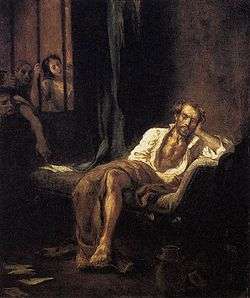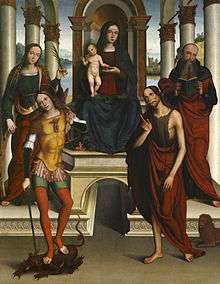Duchy of Ferrara
| Duchy of Ferrara, Modena and Reggio Ducato di Ferrara | |||||||||||
|---|---|---|---|---|---|---|---|---|---|---|---|
| 1450–1597 | |||||||||||
.svg.png) Flag
.svg.png) Coat of arms
| |||||||||||
-en.svg.png) Territories of the House of Este in 1494 (shown in canary yellow) | |||||||||||
| Status | Fiefdom of the Holy Roman Empire | ||||||||||
| Capital | Ferrara | ||||||||||
| Common languages |
Latin (official) Italian (common) | ||||||||||
| Religion | Catholic Church | ||||||||||
| Government | Non-sovereign monarchy | ||||||||||
| Duke of Ferrara | |||||||||||
• 1450–1471 | Borso I | ||||||||||
• 1559–1597 | Alfonso II | ||||||||||
| History | |||||||||||
• Borso d'Este becomes Duke | 1450 | ||||||||||
• Modena and Reggio become Duchies | 1452 | ||||||||||
• Ferrara made into Duchy | 1471 | ||||||||||
• House of Este lose Ferrara to Papacy | 1597 | ||||||||||
| Currency | Ferrara mint | ||||||||||
| |||||||||||
The Duchy of Ferrara (Italian: Ducato di Ferrara) was a sovereign state in what is now northern Italy. It consisted of about 1,100 km2 south of the lower Po River, stretching to the valley of the lower Reno River, including the city of Ferrara. The territory was ruled by the House of Este from 1146 as vassals of the Holy Roman Empire.
In 1471, the territory was transferred from the Empire to the Papal States. Borso d'Este, already Duke of Modena and Reggio, was created Duke of Ferrara by Pope Paul II. Borso and his successors ruled Ferrara as a quasi-sovereign state until 1597, when it came under direct papal rule.
Background

The origin of Ferrara is uncertain. It was probably settled by the inhabitants of the lagoons at the mouth of the Po. There are two early centers of settlement: one round the cathedral,[1] the other, the castrum bizantino, being the San Pietro district, on the opposite shore, where the Primaro empties into the Volano channel. Ferrara appears first in a document of the Lombard king Desiderius of 753 AD,[2] as a city forming part of the Exarchate of Ravenna. Desiderius pledged a Lombard ducatus ferrariae ("Duchy of Ferrara") in 757 to Pope Stephen II.
Middle Ages
In 984, Ferrara was given as a fief to Tedaldo, count of Modena and Canossa, nephew of Emperor Otto I. Ferrara afterwards became independent, but in 1101 was besieged and taken by Matilda of Tuscany. At this time it was mainly dominated by several great families, among them the prominent Adelardi (or Aleardi) family.
In 1146, Guglielmo II of Adelardi, the last of the House of Adelardi, died, and his property passed, as the dowry of his niece the Marchesella, to Obizzo I of Este. There was considerable hostility between the newly entered family and the prominent Salinguerra family, but after considerable struggles Azzo VII of Este was nominated perpetual podestà in 1242. In 1259 Azzo captured Ezzelino of Verona in battle. Azzo's grandson, Obizzo II (1264–1293), succeeded him, and was made perpetual lord of the city by the population in 1264.
The House of Este was from henceforth settled in Ferrara. Obizzo also became lord of nearby Modena in 1288 and of Reggio in 1289.
Niccolò III (1393–1441) received several popes with great magnificence, especially Eugene IV, who held a council here in 1438. In 1452, Emperor Frederick III created Niccolò's son and successor Borso Duke of the imperial fiefs of Modena and Reggio. (That same year, Girolamo Savonarola was born in Ferrara.) In 1471, Ferrara was formally recognized as a fiefdom of the Papal States, and Borso was made Duke of Ferrara by Pope Paul II. Ercole I (1471–1505) carried on a war with Venice and increased the magnificence of the city.
Renaissance
Ercole I d'Este was one of the most important patrons of the arts in late 15th- and early 16th-century Italy, along the Medicis and Pope Julius II. During his reign, Ferrara grew into an international cultural centre, renowned for its architecture, music, literature and visual arts. Ferraranese painters established links with Flemish artists and their techniques, exchanging influences in colors and composition choices.
Composers came to Ferrara from many parts of Europe, especially France and Flanders. Josquin des Prez worked for Duke Ercole for a time (producing the Missa Hercules dux Ferrariæ, which he wrote for him). Jacob Obrecht came to Ferrara twice (and died during an outbreak of plague there in 1505). Antoine Brumel served as principal court musician from 1505. Alfonso I, son of Ercole, was also an important patron; his preference for instrumental music resulted in Ferrara becoming an important center of composition for the lute.
The architecture of Ferrara benefitted from the genius of Biagio Rossetti, who was asked in 1484 by Ercole I to redesign the plan of the city. The resulting "Addizione Erculea" is one of the most important and beautiful examples of renaissance city planning and contributed to the selection of Ferrara as a World Heritage Site by UNESCO.
Alfonso married the notorious Lucrezia Borgia, and continued the war with Venice with success. In 1509 he was excommunicated by Pope Julius II, and he overcame the pontifical army in 1512 defending Ravenna. (Gaston de Foix fell in this battle, as an ally of Alfonso.) Lucrezia, together with other members of the Este house, is buried in the convent of Corpus Domini.
Alfonso made peace with the succeeding popes. He was the patron of Ariosto from 1518 onwards. His son Ercole II married Renée of France, daughter of Louis XII of France; he too embellished Ferrara during his reign (1534–1559).

His son Alfonso II married Lucrezia, daughter of grand-duke Cosimo I of Tuscany, then Barbara, sister of Emperor Maximilian II and finally Margherita Gonzaga, daughter of the Duke of Mantua. He raised the glory of Ferrara to its highest point, and was the patron of Tasso, Guarini, and Cremonini – favouring, as the princes of his house had always done, the arts and sciences. During the reign of Alfonso II, Ferrara once again developed an opulent court with an impressive musical establishment, rivaled in Italy only by the adjacent city of Venice, and the traditional musical centers such as Rome, Florence, and Milan. Composers such as Luzzasco Luzzaschi, Lodovico Agostini, and later Carlo Gesualdo, represented the avant-garde tendency of the composers there, writing for gifted virtuoso performers, including the famous concerto di donne — the three virtuoso female singers Laura Peverara, Anna Guarini, and Livia d'Arco. Vincenzo Galilei praised the work of Luzzaschi, and Girolamo Frescobaldi studied with him.
The city was much affected by the 1570 Ferrara earthquake.
When Alfonso died in 1597, he had no legitimate male heir. The Este lands were inherited by Alfonso's cousin Cesare d'Este. However, the succession was not acknowledged by Pope Clement VIII. Ferrara was claimed as a vacant fief by the Pope, as was Comacchio. The House of Este retained Modena and Reggio, which they held until 1796, apart from short interludes.
Este Lords of Ferrara, Modena, and Reggio

- Obizzo II d'Este 1264–1293
- Azzo VIII 1293–1308
- Aldobrandino II 1308–1326
- Obizzo III 1317–1352
- Niccolò I 1317–1335
- Aldobrandino III 1335–1361
- Niccolò II 1361–1388
- Alberto 1388–1393
- Niccolò III 1393–1441
- Leonello 1441–1450
Este Dukes of Ferrara, Modena, and Reggio
- Borso 1450-1471 (Duke of Modena and Reggio from 1452, Duke of Ferrara from 1471)
- Ercole I 1471-1505
- Alfonso I 1505-1534
- Ercole II 1534-1559
- Alfonso II 1559-1597
- 1597- to the Papal States
See also
References
- ↑ The See was moved here from Vicohabentia (Voghenza) in 624 (Chronology of Catholic dioceses: Italy).
- ↑ Archived December 1, 2010, at the Wayback Machine.
- ↑ "Madonna and Child Enthroned with Saints". The Walters Art Museum.
Sources
- Trevor Dean, Land and Power in Late Medieval Ferrara: The Rule of the Este, 1350-1450.(Cambridge University Press) 1987.
- Cecily Booth, Cosimo I - Duke Of Florence, 1921, University Press
External links
- Il Castello Estense: genealogical tree
- Dosso Dossi: Court Painter in Renaissance Ferrara, a full text exhibition catalog from the Metropolitan Museum of Art.